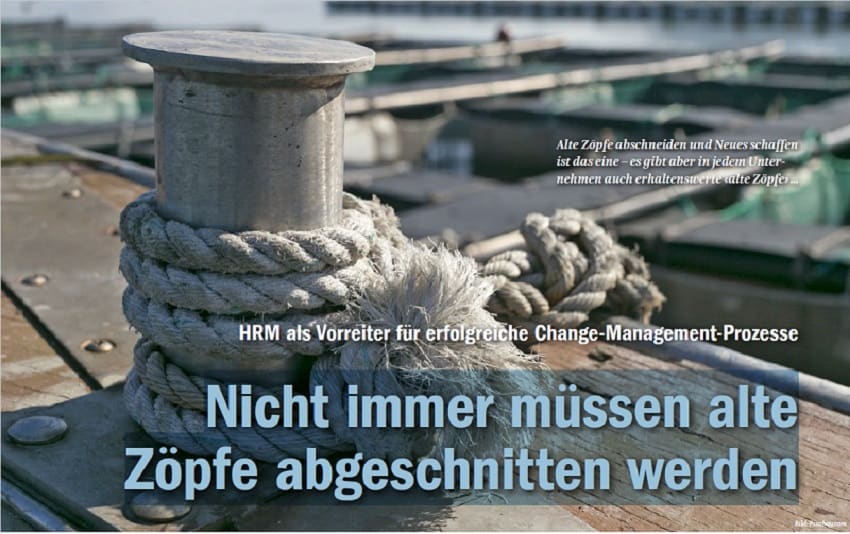Old habits do not always have to be cut off
Quite a few companies are undergoing a rapid process of change. But when many things are changing, constants are also needed so that the balance does not get out of joint. HRM plays a central role in this process. Specifically: Even in the age of digitalization and robotization, people must remain the focus!

Lio is a robot specially developed for personal care and is currently being used in some hospitals and old people's centres; it is designed so that "people like it" - that is the motto of the manufacturers. Contrary to popular opinion, 53 per cent of the thousand people surveyed (or those affected) would give a thoroughly positive assessment of the use of computer-controlled care robots with certain restrictions (familiarisation period). This optimistic view is understandable in view of the shortage of skilled workers, the progressive rise in care costs and the advance of digitalisation (survey by the opinion research institute Demoscope). Of course, artificial intelligence established in computers cannot replace human warmth and affection! The successive use of Lio is intended as a sensible addition to a modern care concept - no more, but also no less!
HRM as "communicator of change
The partially robotized nursing service - representative of other areas - is just one example of the ongoing digitalization and robotization in a wide variety of companies: In order to prevent a loss of the emotional bond between our employees and their place of work, company bosses and HR managers must assume their role as leaders in change management processes more strongly than in the past and involve their employees in such an - often drastic - phase of change: through listening, appreciation and constructive behavior. This is where managers commit the greatest sins of omission, which can seriously jeopardize the implementation of planned changes.
Appreciation for those affected
I know from my own experience that it is worthwhile to pay attention to each individual employee and to take them seriously. In doing so, you show respect for those affected by the changes. The possibly convenient phrases or excuses such as "I don't have the time for personal discussions" or "Today is an inopportune time" or "What does this troublemaker want again? If we as HR managers do not take the time to deal with the concerns, suggestions, worries and needs of the staff, this is perceived - rightly, in my opinion - as a lack of appreciation, and by particularly motivated employees even as "killer behaviour". Particularly in difficult times of change (reorganization, merger, restructuring, digitalization, etc.), committed key people with a high level of commitment are needed in addition to decisive action.
Do not throw everything overboard
I'm sure you've heard the modern and oft-used catchphrase that goes like this, "The only constant is change." But for all the need to trim old habits and create new ones: A company that constantly reorganizes and reorients itself exclusively runs the risk of going off the rails and losing its course. At the same time, employees also lose their orientation and no longer know where the path is leading.
In practically every company, there are also "old habits" worth preserving, which we should treat with respect. For example, what at first glance appears to be a tempting potential for savings by simply cutting jobs can turn into a boomerang if the company's previous excellent reputation - i.e. the "old hair" - goes down the drain. A possible - and intelligent - alternative in the sense of best practice would be to implement new employment opportunities in other areas instead of the planned redundancies in order to become even more efficient and faster than the competition. Here, too, HR managers and line managers can play their part by promoting the employability of employees from a wide range of professions, functions and hierarchical levels through targeted training measures.
Statement of an HR leader: "I myself am the magazine that announces the change".
The targeted involvement of staff is the be-all and end-all of any successful change process. Open and timely information is at the top of the priority list. However, good communication does not necessarily require an extensive glossy brochure. I know from an HR manager friend of mine that he has explicitly dispensed with such an information tool. "I myself am the magazine that announces the wan del" - and has carried it out. His probably somewhat unconventional method of ad hoc information had the undeniable advantage that it was understood by everyone. Conclusion: HR managers as communicators of change!
Involving staff in change processes
Successful change management turns as many employees as possible into co-change agents and not into change losers! It is important that you give your staff, who are willing to perform, a new operational home despite all the flexibility that is required. If you succeed - and here you are particularly addressed as HR managers together with the company management - in awakening positive feelings for change processes, much has already been gained. Successful mergers and restructurings confirm the high value of emotions, which is also proven by relevant studies and research results.









